
“HISTORICALLY PLAGUED BY THE image of a tin box on wheels, manufactured housing finally is winning some of the mainstream acceptability that this housing segment has long sought. Today, manufactured housing—also mistakenly known as mobile homes, a colloquial but technically inaccurate name sometimes used to describe the housing product broader homeowning audience.”
– Donald S. Bradley,
senior economist in Freddie Mac’s housing economics department.
It was a dramatically different time, and to be blunt, short term thinking back then in manufactured housing doubtlessly cost the industry tens of billions annually in new factory-built home sales.
The year was 1998, and the bust from the easy-credit go-go days of liar loans and questionable documentation was getting ready to bust. So, the researchers of that era did not yet know what we know today.

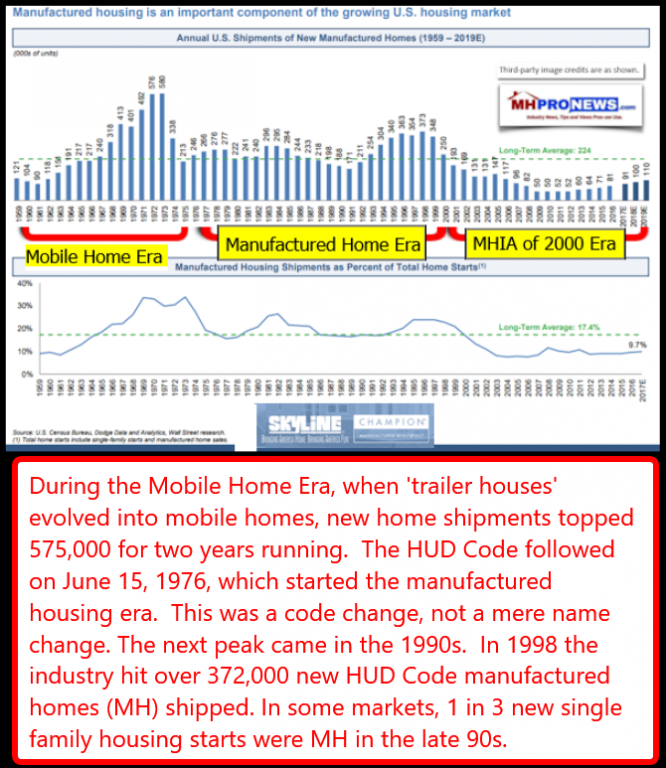
That said, the praise from third-party researchers then was plentiful. And Fannie Mae seriously asked the following question in a research document:
Will Manufactured Housing Become Housing of First Choice?
Before you think that the report and headline were a one-off, recall that Eric Belsky made the statements in the graphic shown below. He did so a few years later, knowing about the repossessions, foreclosures and the constricting of lending that were occurring by that time.
– Harvard,
– a GSE,
– the Ford Foundation,
– and others were seeing the future of American Housing as coming out of a HUD Code manufactured home factory.
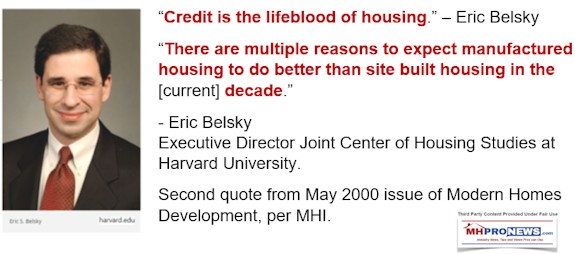
The proverbial table could be set for that type of future again, where manufactured and factory-built housing might be poised to overtake convention building, because the demand for housing is so great.
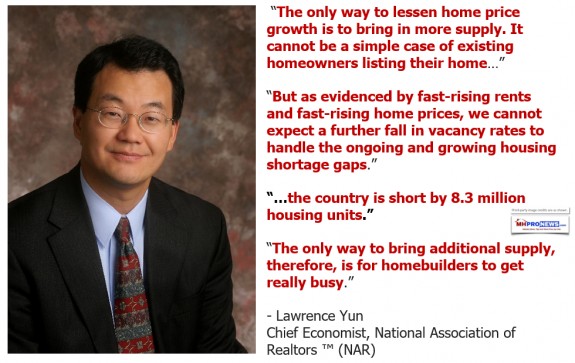
And the gap between what site builders can do and what is needed is so wide that among the tech giants are those who believe that only factory building will accomplish the closing of the gap.
This article will only reference briefly as related reports at the end what the Urban Institute failed to note in an otherwise largely useful report that published on manufactured housing in January 2018.
But some of the takeaways found in these reports from the late 90s and early 2000s are still valid today. and ought to be required reading for industry professionals, investors, public officials, policy and housing advocates. The research we need today is research that’s already been done, time and again.
The excuses – pardon the bluntness – that the GSEs give today find their answer in some of their own research documents from the past, along side that of other third parties that praise the manufactured housing industry’s product.
What about today?
In fact, a recent report by the Manufactured Housing Association for Regulatory Reform (MHARR) makes it clear the quality of manufactured housing is – as HUD Secretary Ben Carson said, “Amazing!” is proven by federal data that proves that only a tiny fraction of a single percent of the homes produced ever go to dispute resolution. Keep in mind that the feds under Pam Danner’s watch at HUD started essentially advertising for complaints, because there were so few of them.
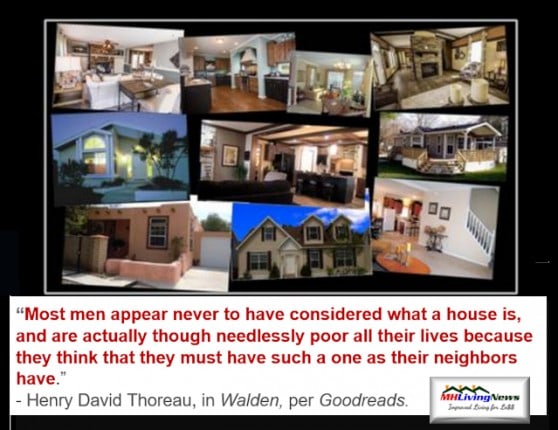
The extended quotes that follow are from a Ford Foundation report. The entire document will be linked as a download at the end.
The opening quotes above are from a Freddie Mac report, which will also be linked at the end as a download.
The closing thought for this is simple. For at least 2 decades, the manufactured housing industry has allowed itself to be defined by others. The industry has built a fine product for decades. The foundation for having the industry defining itself has been set.
The industry has the laws that it needs, now what is needed is to see those laws be fully enforced.
Back then, or more recently, there are media and researchers who discover that the solution to the affordable housing crisis is hiding in plain sight.
https://www.manufacturedhomelivingnews.com/bloomberg-housingwire-realtor-and-fox-all-suggest-manufactured-homes-as-important-solution-for-affordable-housing-in-america/
It is up to the individual businesses, or through a collective effort, to redefine in the public mind the myths vs. the realities. Please don’t take this as hubris, but we helped set the foundation for getting to the heart of what bothers consumers, media, researchers, and others when we launched – thanks to the support of others – MHLivingNews.com.
https://www.manufacturedhomelivingnews.com/surprised-by-the-truth-while-shopping-for-a-new-home/
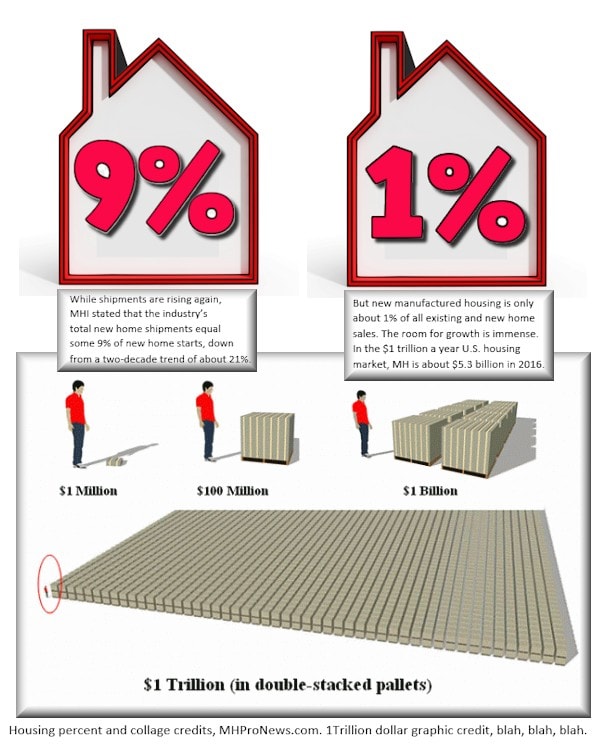
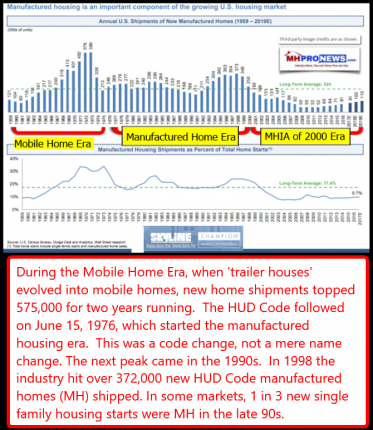
What is self-evident from the new home shipment levels is that the industry’s ‘leadership’ failed terribly at protecting, educating and promoting the true value of our product.
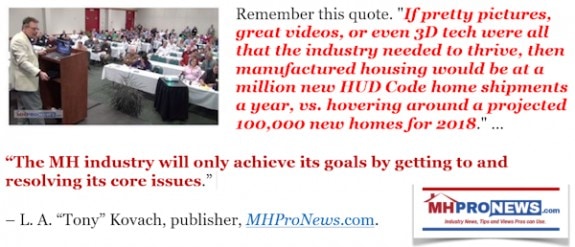
- Evidenced-based education must be first to each other as professionals.
- Then, education must then go out to our home owners and the rest of the general public.
- We must not fear the truth. Our product doesn’t have to be perfect, it just has to be a prudent option. Site built housing is demonstrably not perfect, ours doesn’t have to be either.
- There has to be some bold and courageous enough to stand up in their own respective field and do what a group of communities are doing, forge a new association that will address the needs that decades of history reveal hasn’t been solved by current leadership.
The proof of our quality and the reality of what holds us back are what MHProNews and MHLivingNews, with the support of others, has been documenting for years. Those focus group videos are evidence of what happy manufactured home owners look like.
https://www.manufacturedhomelivingnews.com/affordable-housing-focus-group-comparing-housing-options-conventional-houses-condo-rentals-and-manufactured-homes-up-for-growth-national-association-of-realtor-studies/
The solution for the affordable housing crisis has been hiding in plain sight.
Since we’ve said those words, others in media have picked it up, time and again. That too is part of the proof of what is needed. Honest engagement with the media, researchers, advocates, home-shoppers, and public officials.
https://www.manufacturedhomelivingnews.com/the-solution-to-the-affordable-housing-crisis-is-hiding-in-plain-sight/
These reports from third parties from the glory days not so long past point the way foreword, for those willing to make common sense changes that bring new, more profitable and sustainable results.
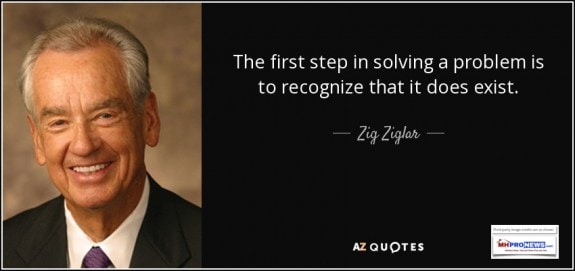
That said, let’s dive into the powerful opening to the Ford Foundation, in the extended quotes below.

ABSTRACT OF FINDINGS
“An increasing share of lower-income families, the same population targeted by community-development organizations, are opting to live in housing that was built off-site in a factory to meet the performance standards of the national HUD manufactured-housing code. However, most community-development practitioners are just beginning to come to terms with the implications of manufactured housing for their work.

As a companion to this paper, an exhaustive literature review has been compiled.
INTRODUCTION
There are over eight million manufactured, HUDcode homes in the United States today, representing two-thirds of affordable units added to the stock in recent years and a growing portion of all new housing. In fact, buyers of manufactured homes contributed to a substantial share of the growth in low-income home ownership evidenced in the 1990s. These statistics send a message to all who seek to promote home ownership for low-income families, as well as promote safe, affordable housing opportunities in disenfranchised communities. An increasing share of the people whom community-development organizations serve are opting to live in housing that was built offsite in a factory to meet the performance standards of the national HUD manufactured-housing code. Many community-development practitioners are just beginning to come to terms with the implications of this for their work.

This report and the “Developing Community Assets with Manufactured Housing: Barriers and Opportunities” symposium held in Atlanta in February 2002 by the Neighborhood Reinvestment Corporation are part of an effort to better understand the implications and opportunities of manufactured housing for the community-development field. The goal of this project is to increase education and awareness about manufactured housing among practitioners. Similar to other markets, community-based organizations have the potential to help ensure that consumers make informed choices regarding manufactured housing, and to use programmatic and policy tools to make a positive impact on communities.
To supplement the quantitative findings of research conducted by staff of the Joint Center for Housing Studies of Harvard University, anecdotal information was collected from the national NeighborWorks® network of nonprofit community-development organizations, and model program profiles were developed to provide a more complete picture of the opportunities and challenges of manufactured housing. In addition, focus groups with community-development practitioners, lenders, manufactured-housing retailers, homebuyer-education specialists and actual clients and consumers were convened to assess perceptions, knowledge and experience with manufactured housing. Guiding this research were questions related to the community-development field, namely, what—if anything—should community-development entities be doing about manufactured housing? How can this field begin to discern what improvements in public policy are needed and what programs might be successful?
This report provides a unique overview of manufactured housing, including a thorough analysis of historic trends, household demographics and the characteristics of manufactured stock, as well case studies that highlight innovative programs and developments. As a companion to this report, an exhaustive review of existing literature has also been summarized (beginning on page 49).
- MANUFACTURED HOUSING CONTINUES TO EVOLVE
What is Manufactured Housing?
Manufactured housing began as an offshoot of the recreational-vehicle industry in the 1930s, providing shelter for households with mobile lifestyles as well as temporary housing needs. Following World War II, housing shortages induced many households to turn to mobile homes for permanent shelter. Recognizing an opportunity, during the 1950s the industry began designing and constructing units intended to be permanent shelters. This development engendered some quality improvements, but industrywide standards remained uneven.
Within a few decades, concerns over the quality, durability, health and safety of manufactured homes led to federal action. In 1974 Congress passed the Federal Manufactured Housing Construction and Safety Standards Act, which led to the creation of a national manufactured-housing code (the “HUD code”). Unlike site-built homes, modular housing and other types of factory-produced homes, which are built to a variety of state and local building codes, HUD-code manufactured homes are built to a single, national quality and safety standard. This standard is generally based on the performance of the design and materials, rather than prescribing a specific material type or dimension must be used. Therefore, HUD-code units may use engineered lumber or alternative materials not commonly permitted under local building codes.
Homes built to the HUD code are still built on a permanent chassis like mobile homes built prior to 1976, but HUD-code units are of a higher quality, safer, and more durable than earlier models. Importantly, the HUD code pre-empts state and local building regulations, allowing manufacturers to use standardized building materials and components and avoiding the delays associated with local building inspection procedures.
Because of these streamlined codes, reduced delays and other efficiencies, one of manufactured housing’s most distinctive features is its affordability. These cost advantages do not stem from inherently inferior quality standards in the HUD code as compared to site-built homes. Detailed studies by the University of Michigan and others suggest that quality differences of the local site-built codes compared to the HUD code is minimal (Warner and Johnson 1993, Gordon and Rose 1998). In fact, manufactured housing’s affordability stems largely from cost savings from production processes.
Five factors primarily drive these efficiencies:
- economies of scale in high-volume materials purchase,
- ability to better coordinate production using assembly-line techniques,
- a controlled environment devoid of weather or other delays,
- standardized design and materials, and
- reduced costs (primarily time) of securing approval from local code officials.
Overall these advantages can generate significant cost savings, as indicated by a recent HUD study showing that building a 2,000-square-foot manufactured unit costs just 61 percent as much as a comparable sitebuilt home (HUD 1998)…”
— end of extended quotes —
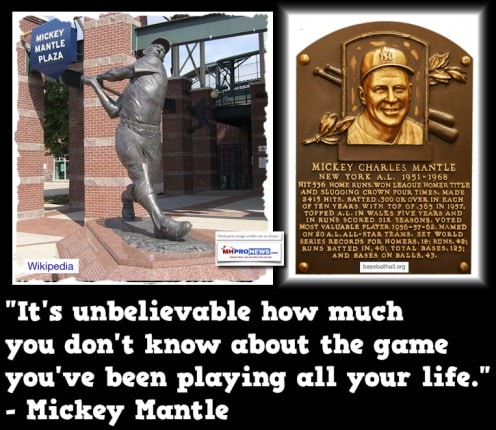
Freddie Mac Report on Manufactured Housing Poised to Overtake Conventional Housing, download linked here.
Report to the Ford Foundation, download linked here.

Let’s not let self-limiting thinking rob us, and the nation, of what could be a much brighter, richer future for all. The report linked below demonstrates how our industry could help grow the economy by some two trillion dollars annually.
YIMBY vs. NIMBY, Obama Admin Concept Could Unlock $1.95 Trillion Annually, HUD & MH Impact
Make no mistake. The headline question is why Warren Buffett and other billionaires and multi-billion dollar operations are in this industry.
“We Provide, You Decide.” © ## (News, analysis, and commentary.)
(Third party images, content are provided under fair use guidelines.)
Related Reports:

HUD’s New Man, Officials Statements, with Insider Info Beyond the Media Releases
Progressive “Nation” Reports on Monopolies Cites Buffett, Clayton, Others – MH Industry Impact?

1) To sign up in seconds for our MH Industry leading emailed news updates, click here.
2) To provide a News Tips and/or Commentary, click the link to the left. Please note if comments are on-or-off the record, thank you.
3) Marketing, Web, Video, Consulting, Recruiting and Training Resources

By L. A. Tony’ Kovach, publisher of MHProNews.com.
Tony is the award-winning managing member of LifeStyle Factory Homes, LLC, the parent company to MHProNews, and MHLivingNews.com.
